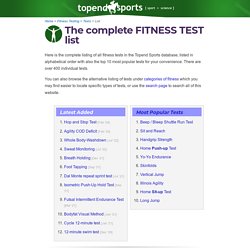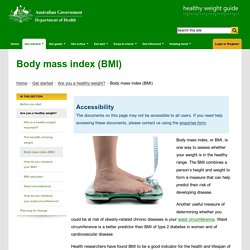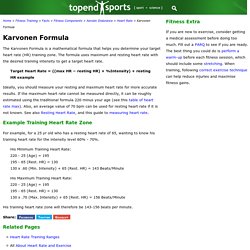

Warm-Ups - Science for Sport. Warm-Up Procedures Warm-ups most commonly last for approximately 10-30 minutes, meaning all desired content must be strategically factored in this short period of time. Though each warm-up is short, over a long timeframe such as a 12-week training cycle, the accumulation of a 10-30 minute warm-up each session equates to a huge increase in total training time. For example: A 15-minute warm-up performed 4 x per week for 12-weeks = 12 hours of training time. Over a 12-week training cycle, the exercise professional can utilise an additional 12-hours of high-quality training time. In an attempt to advance current performance preparation practices, two primary warm-up models have been developed by Dr. RaiseActivate and MobilisePotentiate (or Performance in this articles modified variation of the RAMP protocol) The Beep Test audio Full.
Ruler Drop Test. Testing and measurement are the means of collecting information upon which subsequent performance evaluations and decisions are made.

In the analysis, we need to bear in mind the factors that may influence the results. Objective The objective of this test is to monitor the athlete's reaction time. Required Resources To conduct this test, you will require: Metre ruler Assistant How to conduct the test. Reflex Test - Check your Reaction Speed. Reaction Time Test. Topic 6: Measurement and Evaluation - IB. Physical Educ8or: IB SEHS: Topic 6: Principles of Training.
Fitness Test List. Home > Fitness Testing > Tests > List Here is the complete listing of all fitness tests in the Topend Sports database, listed in alphabetical order with also the top 10 most popular tests for your convenience.

There are nearly 400 individual tests. You can also browse the alternative listing of tests under categories of fitness which you may find easier to locate specific types of tests, or use the search page to search all of this website. Performance Testing. Body Composition Methods: Comparisons and Interpretation. Hydrostatic Underwater Weighing. Home > Fitness Testing > Tests > Anthropometry > Body Composition > Underwater Hydrostatic weighing, also known as Hydrodensitometry or underwater weighing, is a classic measure of body composition. purpose: the aim of underwater weighing is to measure the density of the body, and from that figure calculate percentage body fat equipment required: Hydrostatic stainless steel weighing tank, including underwater mounted chair and scale, weighted belt and nose clip.
A more simple set up may include a chair and scale suspended from a diving board over a pool or hot tub. pre-test: Explain the test procedures to the subject. Perform screening of health risks and obtain informed consent. Prepare forms and record basic information such as age, height, body weight, gender. Share: Facebook Twitter Related Pages Popular Content Comments. The Heart Foundation. Healthy Weight Guide. Accessibility The documents on this page may not be accessible to all users.

If you need help accessing these documents, please contact us using the enquiries form. Body mass index, or BMI, is one way to assess whether your weight is in the healthy range. The BMI combines a person’s height and weight to form a measure that can help predict their risk of developing disease. Another useful measure of determining whether you could be at risk of obesity-related chronic diseases is your waist circumference. Health researchers have found BMI to be a good indicator for the health and lifespan of adults – not necessarily for an individual, but for a group of people who have the same BMI. Although BMI is not a perfect measure, it is generally agreed to be the most useful and valid for adults.
Differences in BMI When calculating BMI, for adults a result between 18.5 and 24.9 is considered to be within the healthy weight range. Complete Guide to Fitness Testing. Categories of Fitness Testing. Rating of perceived exertion Borg scale. How to Use the Perceived Exertion Scale During Exercise. Exercise intensity is important to gauge because it can tell you whether you are working too hard or not working hard enough. One common way to do this is using a Rating of Perceived Exertion (RPE). The talk test, your target heart rate range, and the Borg Rating of Perceived Exertion (RPE) are all methods for determining how hard you are exercising. Learn how to use your RPE to determine whether you are exercising in the moderate-intensity or vigorous-intensity zones. The BORG SCALE And RPE Explained. Heart Rate Karvonen Formula. Home > Fitness Training > Facts > Fitness Components > Aerobic Endurance > Heart Rate > Karvonen Formula The Karvonen Formula is a mathematical formula that helps you determine your target heart rate (HR) training zone.

The formula uses maximum and resting heart rate with the desired training intensity to get a target heart rate. Target Heart Rate = ((max HR − resting HR) × %Intensity) + resting HR example Ideally, you should measure your resting and maximum heart rate for more accurate results. Nike’s Fastest Shoes May Give Runners an Even Bigger Advantage Than We Thought. Anyone who saw Eliud Kipchoge of Kenya break the two-hour marathon barrier in October very likely saw something else, too: the thick-soled Nike running shoes on his feet, and, in a blaze of pink, on the feet of the pacers surrounding him.

Photograph by Joe Toth/The INEOS 1:59 Challenge via AP; illustration by The New York Times These kinds of shoes from Nike — which feature carbon plates and springy midsole foam — have become an explosive issue among runners, as professional and amateur racers alike debate whether the shoes save so much energy that they amount to an unfair advantage. A new analysis by The New York Times, an update of the one conducted last summer, suggests that the advantage these shoes bestow is real — and larger than previously estimated. At the moment, they appear to be among only a handful of popular shoes that matter at all for race performance, and the gap between them and the next-fastest popular shoe has only widened. Using statistical models to measure shoe effect.